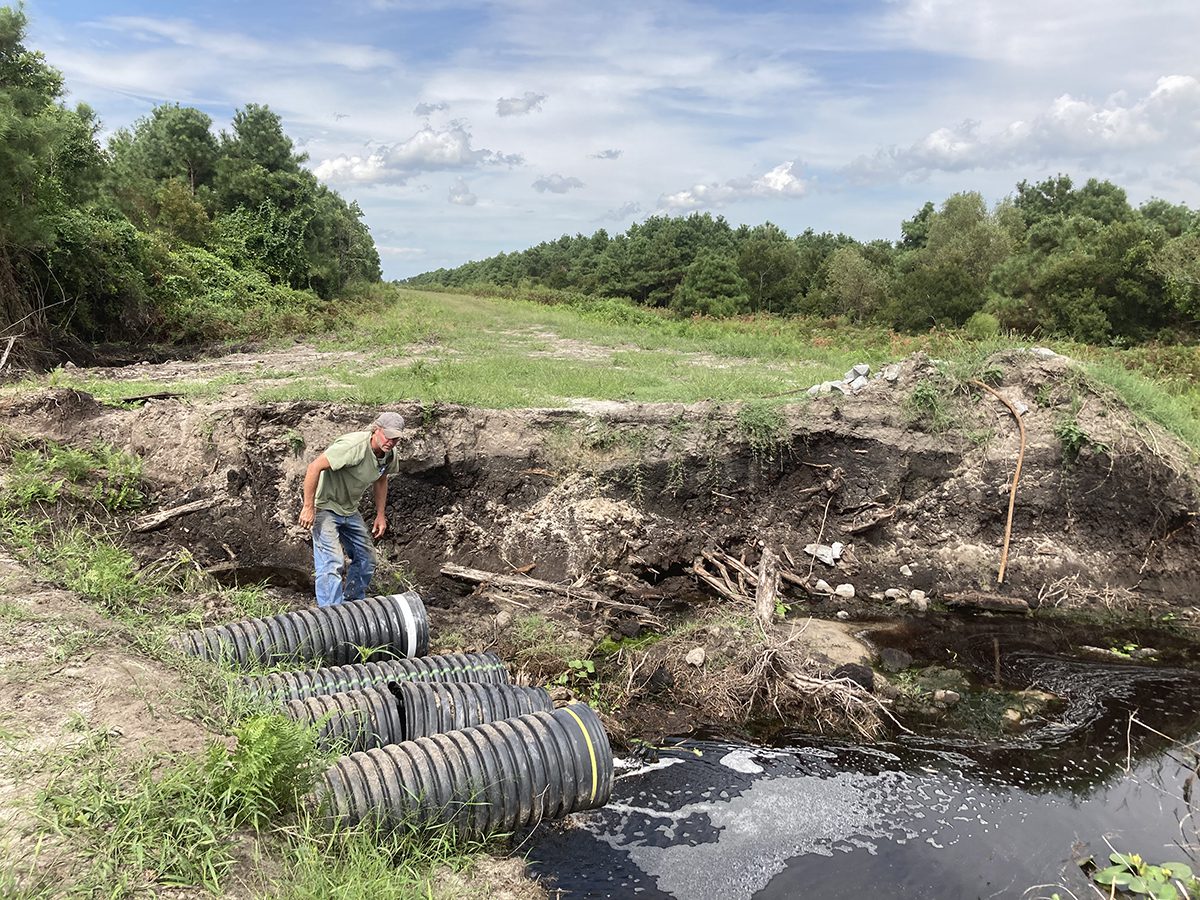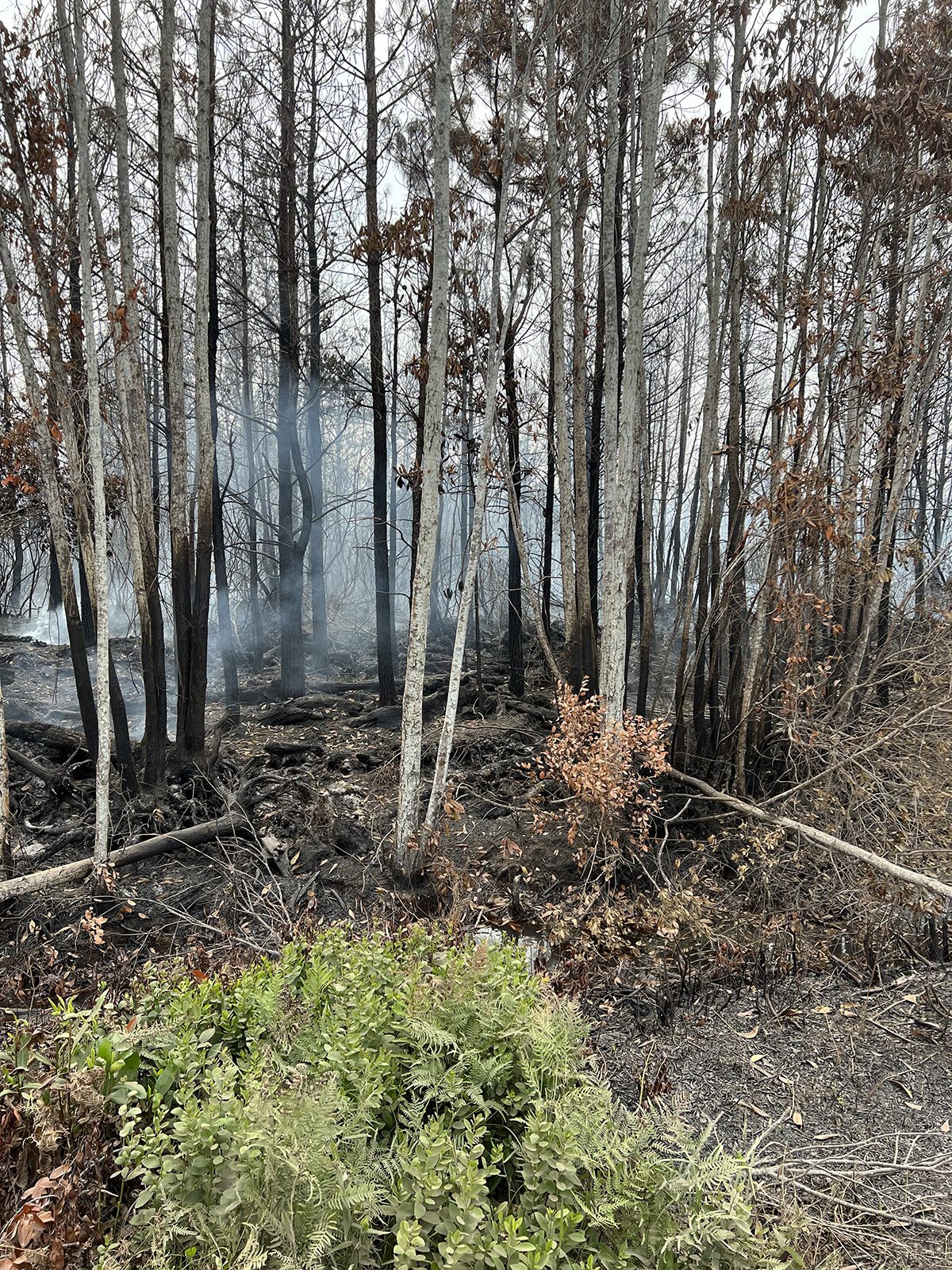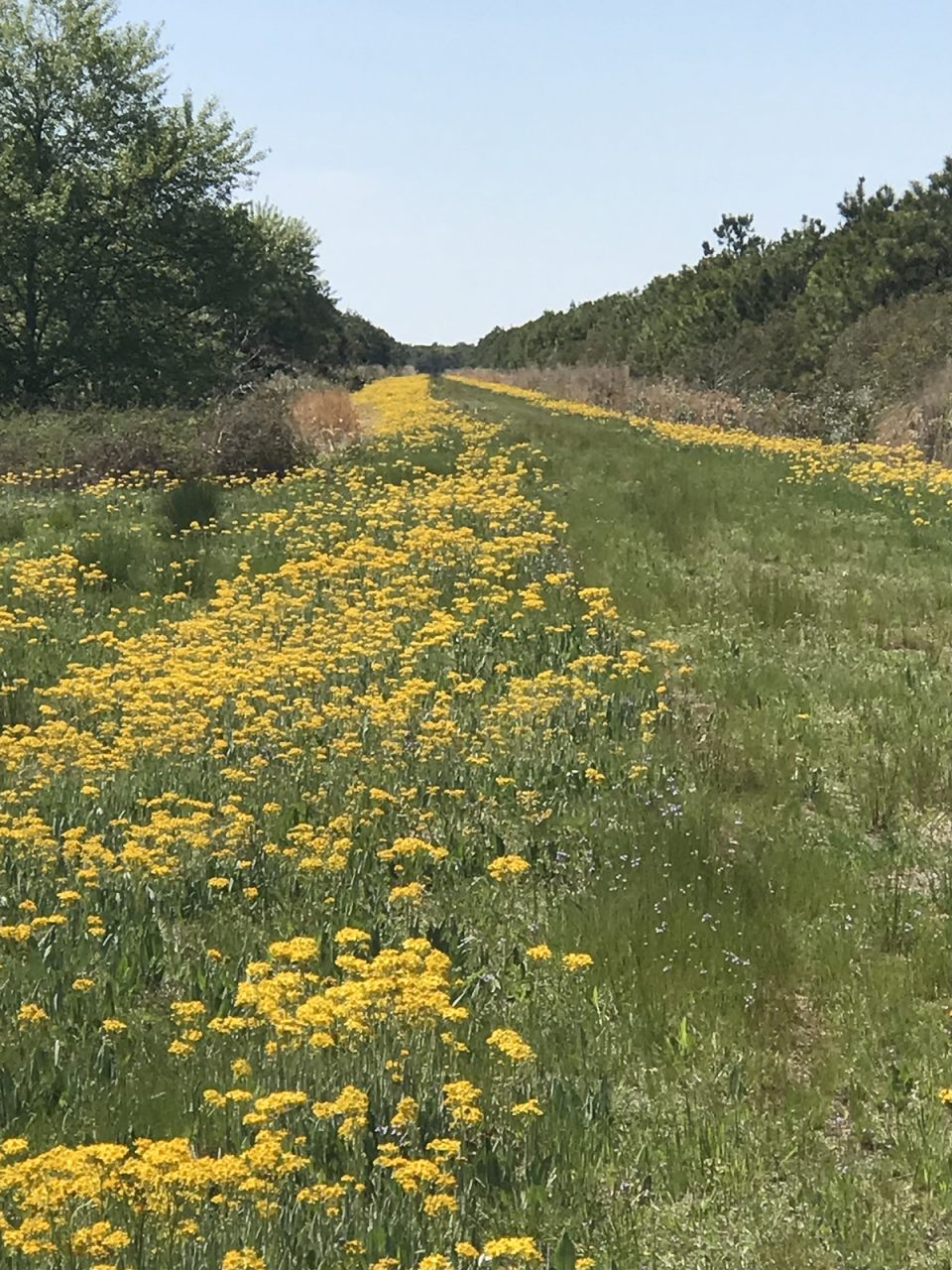
First of two parts.
BELHAVEN — Fourteen years separate two lightning strikes that sparked wildfires in nearly the same spot of private land near Pocosin Lakes National Wildlife Refuge.
Supporter Spotlight
The first blaze in 2008 consumed about 50,000 acres and took more than six months to extinguish. The second, in June 2022, burned just under 2,000 acres and was out in 10 days.
To Angie Tooley, manager of Carolina Ranch, the 10,000-acre site where both fires ignited, those contrasts illustrate the critical difference between toasty dry pocosin and spongy wet pocosin. Tooley credits the ranch’s work that rewetted the pocosin by raising water levels in the canals for suppressing the June fire.
But moist pocosin can also translate to income, she is quick to add. When peatlands are restored to their naturally boggy health, their thick mats of decayed plants sequester many tons of carbon. Carbon dioxide is the greenhouse gas that is threatening to destroy our planet.
It’s an opportunity for ecosystem restoration that kills two birds with one stone — wildfire prevention and climate change mitigation — and Tooley intends to seize the ring. In recent years, she has reached out to environmental nonprofit group The Nature Conservancy, or TNC, and Charlottesville, Virginia, consulting firm TerraCarbon for expertise to help Carolina Ranch — and possibly neighboring properties — meet strict criteria to qualify for the burgeoning carbon credit market.
Carbon credits, or offsets, refer to the amount of greenhouse gas removed from the atmosphere, or the reduction of carbon emissions. Carbon farming creates credits based on the carbon dioxide, or CO2, held or drawn down into the soil.
Supporter Spotlight
“We are all looking for ways to work together in showcasing the private landowner use of the pocosin carbon offsets methodology funded by TNC and written in part by TerraCarbon,” she said in a text message after representatives of the groups had visited the site Jan. 11.

Wetland research
The Duke University Wetland Center, which is led by founding director Curtis J. Richardson, had conducted a three-year research project on pocosin in Carolina Ranch and, earlier, at the Pocosin Lakes refuge. In a paper released in September, the research data showed that rewetting and restoring 250,000 acres of previously drained peatlands could prevent 4.3 million tons of CO2 from being released into the atmosphere – equaling 2.4% of the total annual reductions in carbon dioxide emissions needed for the U.S. to be carbon neutral by 2050.
“Thus, management of hydrology and fire intensity in natural and degraded shrub/tree peatlands will be principal to maintaining peat/litter quality (phenolic/black carbon), enhancing long-term carbon accumulation, and preventing downstream (dissolved organic carbon) losses to coastal waters,” according to the paper.
In September, Richardson told Coastal Review that the Duke center is no longer working with anyone at Carolina Ranch. Although he noted “there’s a million steps that have to be done,” he hopes they move forward with carbon farming.
“I wish the project to be a success,” he said.

‘Hottest of the hot’
During a mid-September tour of the canal system within the project site, Tooley and ranch assistant Bill Ogburn of Ponser showed how the dark water sat just under the top edge of the canals that crisscrossed miles of flat grassy and wooded land.
“This is the worst part of the fire,” Tooley said, nodding towards charred vegetation off the access road on the property. “This was the hottest of the hot.”
Abutting the refuge and situated among vast farms of Hyde County’s coastal plain, Carolina Ranch totals 15,000 acres, some of which is still farmed or used for other purposes. Bumping along in an open all-terrain vehicle, views off the unpaved road showed off nature at its lovely best, mostly untouched by fire. The air had an earthy scent, with an occasional whiff of charred wood. Off the road, palm pine, wild asters, Carolina bay trees, maple, wild dogwood, wax myrtle, fern, scrub bushes and white pines grew with abandon. Wild blackberries, blueberries, gall berry, and wild Scuppernong grapes dotted the landscape in their late summer version. When the vehicle was stopped, it was quiet enough for black bear families to amble across the road. In one large section, there were patches of blackened earth and numerous downed trees.
We arrived at the fire scar.
“Look at the pine – it’s coming back,” Tooley exclaimed, pleased with the signs of recovery.
The property, today owned by Gus Schad of Albemarle, had once been part of the sprawling First Colony Farms, established in 1973 and comprised of 376,000 acres in Washington, Tyrrell, Hyde, and Dare counties. At the time, plans included clearing land for farming, forestry, raising livestock and peat mining. Much of the land was ditched and drained.
But concerns about loss of wetlands and harm to water quality, combined with economic questions, led to the project being dropped. A conservation group eventually bought much of the land at a bankruptcy proceeding, and a large portion became part of Pocosin Lakes National Wildlife Refuge.
After Schad, as Hyde County Partners LLC, purchased the 15,000 acres, he asked Tooley, an old friend, to help manage it and find a way to make a return on the investment. Tooley, an Elizabeth City native whose previous work includes serving as Hyde County planner and county manager, researched options for the land and realized it was a perfect fit for carbon farming. Much work, she knew, would be required to restore the pocosin, which had been dried out by the ditching and draining and periods of drought.

‘What we’re doing is working’
Ambitions for Carolina Ranch, which was incorporated in Sept. 2020, are big, according to its website: “Dedicated 10,000 acres to carbon offsets development in order to strengthen upland conservation, manage rainwater runoff using the peat to absorb and protect adjacent landowners, and enhance the natural environment for new biodiversity industrial job creation all while protecting the land from future peat fires.”
It would be one of the largest coastal resiliency projects in the U.S, continues the writeup on the site. TerraCarbon, which designed the American Carbon Registry methodology for restoration of pocosin wetlands, is directing development of the carbon project, along with East Carolina University and assistance from engineering firm Quible and Associates.
In addition to the prospect for carbon farming, Tooley said that scientists have discovered “never seen before” fungi deep in the peat. The ranch operation is working to continue onsite research into the find, with a goal of developing small business incubators for biodiversity jobs. At the same time, the operation is working to expand use of the property, which has 52 miles of roads, frontage on New Lake and diverse populations of flora and fauna, as a nature-tourism destination.
But without rewetting and restoring the pocosin, the biodiversity and health of the ecosystem would be at risk, Tooley noted, and it would lose any chance of qualifying as a carbon farm. That’s why it is important for the canals to hold the 9 feet of water. As Tooley described it, it was like creating a tub and putting a plug in it. Consequently, the natural sponginess of the peat was absorbed, in turn making it much less of a wildfire hazard.
“I know what we’re doing is working,” she said.
The Algonquin name for “swamp on a hill,” pocosin is the regional version of peat, known for its ability to hold water, and conversely, to burn hot and long. Fifty percent of peat – the remains of dead plants preserved over millennia – is composed of carbon. Despite being only 3% of the Earth’s surface, healthy peatlands store more than twice the carbon of all the planet’s combined forests. Desiccated or burned peat, however, releases carbon into the atmosphere.
Peat fires burn deep into the ground and are notoriously difficult to extinguish because they can spread horizontally and create hot spots that are difficult to find until they flare up. With their carbon-rich material – peat is still mined throughout the world for fuel – peat fires are some of the worst carbon polluters. Paradoxically, it is also one of the best natural solutions to keeping carbon in the ground.
John Cook, District 13 forester with the North Carolina Forest Service, told Coastal Review that the Evans Fire in 2008 happened after two years of severe drought, making the underground organic soil, which lacks sand or clay, exceptionally dry. Then once the topsoil is on fire, the heat keeps drying the soil deeper and deeper.
Even though there was a shorter-term drought going on when lightning ignited the recent wildfire, dubbed the Ferebee Road fire, the strategy at the ranch to dam canals with stacks of cement bags to sustain optimal water levels throughout the 10,000 acres is currently incomplete. The agency has a right to go on private land to stop a fire so it won’t affect somebody else, he added.
“They just don’t have the structures yet to hold water,” he said. “The ditching got ahead of the reality.”
Roads and ditches tend to eventually work like dikes, Cook said. And the problem with pocosin is that when flooded from above, the top of the “swamp on a hill” ends up becoming the center of a doughnut. Firefighters learned from the Evans Fire, which spread underground, and pumped water into canals from nearby lakes to flood the fire from below. Firefighters also cut firebreaks through the land and around the perimeter of the fire, and doused the sides and edges of the fire to keep it from spreading.
Cook said that holding the 9 feet of water Tooley had done at Carolina Ranch did help slow the progress of the Ferebee Road fire, but the more expensive water-control structures used nextdoor at the refuge are able to more efficiently pump water off and on a site as needed to move it around the network of canals.
“She’s doing what she can with what she has, until she can get structures in place,” he said.
Although Tooley wants the Fire Service to fix canal gates and remove cut trees and piles of brush left after the fire, Cook said that is not the agency’s responsibility, comparing it to expecting a fire department to repair your house after it burns. It’s not just because it’s private land, he said.
“I didn’t start the fire,” he said. “I came and put the fire out.”
But he said the service will remove sediments in wetland streams and restore access on paths and roads. Otherwise, the downed growth will be left to nature.
“Those trees are going to rot,” Cook added. “We don’t go back and landscape.”
Spurred by new urgency to mitigate climate change impacts and buoyed by a flood of federal funds, carbon offset projects are gaining momentum nationwide. Tooley remains determined to not only be one of them, but to help use pocosin as an asset to create an innovative business model for the community, while helping to stem the effects of climate change.
“That’s what makes coastal resiliency happen, because it naturally holds water,” Tooley said of northeastern North Carolina’s peatlands. “If everybody doesn’t work together – and I mean public and private – we will never have coastal resiliency.”







